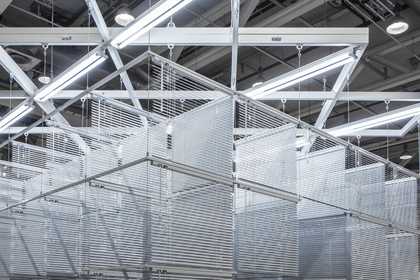
Haegue Yang Sol LeWitt Upside Down – Structure with Three Towers, Expanded 23 Times, Split in Three 2015 © Haegue Yang. Tate, Purchased with funds provided by the Asia Pacific Acquisitions Committee and Kyungsoo Huh, Sung-Moon Kwon, Tae Won Hahn and Byucksan Foundation 2018.
Major works by artists including Haegue Yang, Sarah Sze and Michael Snow
Tate Modern has unveiled a major new acquisition by South Korean artist Haegue Yang. Sol LeWitt Upside Down – Structure with Three Towers, Expanded 23 Times Split in Three 2015, consists of over 500 Venetian blinds suspended dramatically from the ceiling. Yang exploits the unique sculptural possibilities of these ordinary window coverings, allowing the play of light to change as viewers move around, through and under the expansive structure. It is one of many new free displays opening at Tate Modern this winter.
Yang’s sculpture references an iconic work by Sol LeWitt (1928–2007), reinterpreting, magnifying and inverting it to examine conventions of authorship and originality. The work is displayed alongside Sarah Sze’s Seamless 1999 on Level 4 of the Natalie Bell building. Sze’s installation also draws from the visual language of previous generations of artists, from the hanging sculptures of Russian constructivism to the mobiles of Alexander Calder, incorporating familiar objects from everyday life to create miniature worlds suspended in space.
Elsewhere, new sculptures and installations across Tate Modern include Atul Dodiya’s Meditation (with open eyes) 2011 which pays tribute to artists and cultural figures who have inspired him and Doris Salcedo’s evocative sculptures in testament to the victims of Columbia’s horrific civil war. A joint display places James Rosenquist and the artist duo Allora & Calzadilla in dialogue, with both works addressing the idea of humanity looking back at planet Earth from space. On Level 3 of the Blavatnik Building a display will be dedicated to Argentinian artist Judi Werthein’s brand of trainers Brinco, which were distributed free of charge to people attempting to cross the border between Mexico and the USA illegally in 2005. At the same time, The Tanks will feature two immersive installations that play with viewers’ perceptions of sound and light respectively: I See a Darkness 2008 by Susan Philipsz and Your double-lighthouse projection 2002 by Olafur Eliasson.
A number of displays reflect Tate’s commitment to collecting and exhibiting photography. Catherine Opie’s 700 Nimes Road 2010-11 captures an intimate portrait of the late actress Elizabeth Taylor through images of her domestic space and personal belongings, while Walead Beshty’s Travel Pictures 2006-8 depict the ruins of the former Iraqi embassy in East Berlin. Over 20 diaristic photobooks by artists including Nan Goldin, Richard Billingham and Corinne Day, part of the Martin Parr collection acquired by Tate in 2017, will be shown together at Tate for the first time.
Further highlights include displays of artworks by Ellen Gallagher, which blend fact with fiction, combining abstraction with recognisable images, and The End of the Twentieth Century 1983–5 by Joseph Beuys. Film and performance will also be celebrated, with Michael Snow’s experimental film Wavelength 1969–71 and Penny Siopis’s Obscure White Messenger 2010, an exploration of political frustrations and mental distress combining found home-movie footage and interview transcripts. Photographs documenting Ma Liuming’s investigation of social boundaries and gender identity will be shown, as will Who can erase the traces? 2005 a political performance staged by Regina José Galindo on the streets of Guatemala City and participatory works by Paul Neagu. Lygia Clark and Hélio Oiticica.
For press information and images contact press.office@tate.org.uk or call +44(0)20 7887 8730.
